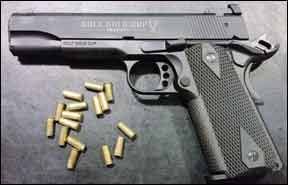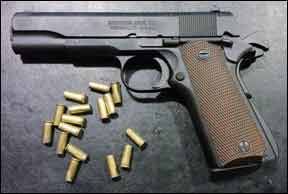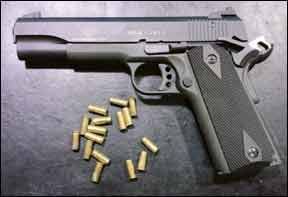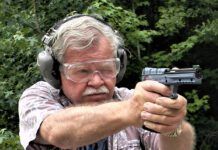If youve wanted a low-cost 22 LR set up with the same controls as your big-bore Model 1911, youre in luck – the number of downsized 1911 guns and kits continues to grow. Rimfire conversion kits for 1911s are one way to go, and we recently favored the Ciener Hi-Power Plus kit (June 2010), but the company has had some setbacks that make us leery of pointing people that direction. The Marvel 1911-22 Practical Conversion, $280 (an Our Pick in the February 2005 issue), and the Advantage Arms 1911-22T, $350 (Grade: A-, June 2010) get the nod now. Weve also covered gun-manufacturer-branded 45-to-22 conversion units, with the Kimber Target Conversion Kit, $330, and the CZ Kadet Adapter, $412, getting Grade: A marks in the February 2010 issue.

If you want a whole new 1911-22 instead of a kit, youve got several choices as well. Many of us would love to have a Colt Series 70 Ace, but those discontinued sidearms are highly-priced collectibles, with recent sales of Aces starting at $1100 on www.GunAuction.com. We liked the Kimber Rimfire Target model, $775, tested in the February 2005 issue, giving that gun a Buy It rating. To expand our coverage of whole-gun 22 LR 1911 replicas, we recently reviewed three units that look and feel very much like 1911s, albeit one is downsized. Our test guns were the full-size Colt Walther Umarex 1911 Gold Cup Trophy No. 2245708 22 LR, $455, and the GSG M1911 No. GERG2210M1911B 22 LR, $365. The Browning 1911-22A2 No. 051802490 22 LR, $509, is one of Brownings two 1911-style rimfires released last year, and this guns compact size offers an interesting contrast to the two larger guns tested against it here.
Introduced in 2011, the 22 Long Rifle platform used for the Umarex Colt Government 1911-22 Series is a licensed reproduction available in three rimfire variants, the Government Models 1911, 1911 Rail Gun, and 1911 Gold Cup. All three Colt Government rimfire models are engineered in true replica form, with fully functioning thumb and grip safeties and the 1911s authentic half-cock mechanism. Grips and sights can be interchanged with a skeleton trigger, combat-style sights, beavertail grip safety, extended thumb safety, and a Commander-style hammer. Like its two brothers, the Colt 1911 Gold Cup Trophy has a 5-inch barrel, 12-round magazine, and drift-adjustable front and rear sights.

Browning introduced its 1911-22 LR Autoloading Pistols in celebration of the 100th anniversary of the classic 1911 pistol designed by John M. Browning. The larger of the new pistols is a 7/8s-size exact replica of the original 1911. That A1 version of the 1911-22 we tested has a 4.25-inch barrel and 5.5-inch sight radius and weighs 15.2 ounces. Overall length on the A1 is 7.1 inches. Our test pistol came with a limited-edition commemorative canvas-and-leather zippered pistol case, but it lacked the first-year-of-production collectors certificate available for guns shipped in 2011.
The Compact 1911-22 version has a 3.6-inch barrel and 4.9-inch sight radius and weighs 15 ounces. Overall length of the Compact is 6.5 inches.
German Sport Guns (GSG), based out of Ense-Hingen, Germany, manufactures our test gun with black-plastic grips along with a wood-grip model and another plastic-grip model with a faux suppressor. The company claims it stuck to existing design and measurements to make the GSG 1911s, building guns that are 80% Mil-Spec, that is, many parts are interchangeable with standard 1911-45 parts. Notably, GSG added a beavertail, grip safety, magazine safety, drop safety, and firing-pin safety to each model, making the products visually resemble and weigh about the same as up-to-date 1911-45s. Also in the parts lists are threaded barrels, which the user can get to by unscrewing a thread cover with a provided wrench. The GSG guns are imported by American Tactical Imports, a worldwide importer of firearms, ammunition, and tactical equipment based in Rochester, New York. ATI provides warranty services, parts, and repairs for the GSG products in the United States.

How We Tested
We first disassembled and lubed all three guns, oiling them as described in the owners manuals. We then took a selection of standard- and high-velocity ammo and function-tested all three, looking for ergonomic or feeding issues. It is often a problem with the scaled-down 1911 design that the small 22 LR round has to move a massive (in size) slide compared to standard 22 pistols, even if the slide is made of lightweight materials, such as the zinc and aluminum alloys employed in these pistols.
In the initial test-firing, we noted that the GSG was balky, and we had a number of malfunctions, the worst of which were light primer strikes, but also failures to eject/extract. The Browning and the Umarex each had one FTF. After familiarization, we cleaned the set, looking in particular at likely trouble spots on the GSG. We checked the plastic follower in the one supplied magazine to see if it needed light sanding or filing – sometimes the lips need adjustment or the plastic follower needs to be reduced slightly. In the gun, it seemed to hang slightly as the follower pushed to the top of the mag. Also, the mag seemed like the plastic follower sometimes caught on the back of the mag lips. Perhaps that would cause failures to feed, since the round wouldnt have the correct angle as it was pushed toward the chamber. What worried us more, however, was how rough the slide-to-frame fit felt. At the range, we noticed that after inserting a fresh magazine and depressing the slide catch, the slide hesitated before it moved forward, and it didnt close smartly. We took the gun apart and considered lightly polishing all the mating surfaces between the slide and the frame.
We decided against it because the gun should come from the factory with the ability to shoot at least some rounds, but we couldnt find one (the selections are listed in the Accuracy and Chronograph sidebar opposite) that would fire consistently. We suffered through the GSGs malfunctions to collect accuracy and velocity data.
In the bench portion of the test, we got a good appreciation for the adjustable, easy-to-see sights on the Umarex and GSG pistols. They were simply easier to manipulate and shoot than the Brownings GI-style rear sight. Also, the triggers on the two larger pistols were substantially better than the Brownings. We go into more detail about these and other crucial areas of form, fit, and function below.
GSG M1911 No. GERG2210M1911B 22 LR, $365
The GSG ships from the factory with two magazines, a 12mm wrench used to take the thread cap off the barrel, a safety lock, a replacement guide-rod buffer disk, one Allen wrench needed for disassembly of the gun, two Allen wrenches needed to drift or replace the sights, a chamber flag, a angled chamber-cleaning brush, and two extra front sight posts of varying heights. Also, it comes factory-equipped with a threaded barrel.
This blowback single-action semi-auto has the heft and feel of a real 1911, with an overall length of 8.6 inches and an unloaded weight of 35 ounces. The 5-inch-long barrel sat inside a black-anodized zinc-alloy slide topped with an easy-to-read black-plastic Novak-style rear sight and blade front sight displaying a yellow-three-dot sight pattern. Our testers liked the hand-filling proportions of the grips, with a 2.3-inch-long frontstrap, a 2.8-inch-long backstrap, and a 6-inch grip circumference at the base. The gun had a reasonable 6.0-pound trigger pull with a small amount of take-up, and all the safeties (grip, disconnector, and firing-pin) felt right and worked as expected. We liked the heavy-gauge workmanship of the supplied 10-round magazines. Midway sells them for $35 each (#760880). We noticed, however, that too ensure proper feeding, its important to seat the rounds as far back in the magazine as possible. In particular, the top round must point up and not nosedive into the mag. Easy fix: Use the thumb stud on the magazine spring to relieve tension on the mag after loading.
The GSG 1911 comes with a number of features that we liked, including ambidextrous safeties, beavertail grip safety, extended trigger with adjustable over-travel screw, Commander-style hammer, and an extended magazine catch. Also, the gun allows for parts interchangeability with standard 45 ACP 1911 parts, including slide stop, barrel bushing, ambidextrous thumb safety, mainspring housing, grip safety, disconnector, hammer and strut, sear and sear spring, grips and grip screws, magazine catch, plunger tube assembly, and trigger. Some will require minor handfitting.
In initial handling, our testers learned that the left-rear corner of the left safety paddle was pretty sharp, but we liked how the 0.282-inch-wide paddle engaged and disengaged. That lower corner would need a single stroke with a fine file to make it more comfortable.
The GSG ships with three front sight blades/bases of different heights. A tiny supplied Allen wrench allows you to loosen a set screw in the top of the front sight and loosen the base, then move the sight around or change it. Another larger Allen wrench loosens the base of the rear sight for windage changes. The GSGs sights, in our view, were much better than the Brownings fixed units, but not as good as the adjustable metal sights on the Umarex Colt.
On pistols like these, we want low operational effort so that new shooters, especially women with weak hands, can manipulate the controls. Our shooters said the Colt Trophy offered the least racking effort, followed by the GSG and the Browning. Smaller-handed shooters had less trouble engaging the grip safety of the Browning than they did the GSG or Colt Trophy, but the big ambi safety paddle on the GSG was the easiest of those safeties to work, followed by the Umarexs paddle and the Brownings button-sized safety. The Browning and the GSG also had magazine-disconnect safeties, but we preferred the Umarex, which didnt have that feature.
Field-stripping is similar to a traditional 1911. After removing the slide stop, the owner must also remove an additional pin thats underneath the slide stop, and a small hex screw forward of the slide stop. After that, the slide comes off, and the rest of the disassembly is straightforward.
None of these three guns should be considered dedicated target pistols, but the GSG and the Umarex are certainly accurate enough to plink on cans. The Umarex was the most accurate with two rounds, shooting the smallest average groups with the Winchester Target and CCI Mini-Mags. The GSG edged the Umarex out with Winchester Golden Bullets.
Our Team Said: As we noted at the outset, our biggest challenges with the GSG were making it work. We tried a mixture of high-velocity and standard-velocity rounds searching for an ammo that it would digest reliably. We believe the issues are fixable, but we chose not to really work the innards until we gave the factory a chance to look it over. A spokesman for the company said, We do have concerns about what might be wrong with the gun, because we have had several reviews on this gun in the past year and a half and have never had a report of problems. We definitely want to figure out what the problem is and make it right.
Browning 1911-22A1 No. 051802490 22 LR, $509
The frame and slide of the Browning 1911-22 are machined from aluminum alloy with a matte finish. The barrel has a stainless-steel barrel block, target crown, single-action trigger, and simple blowback action. Wed guess the big cost difference for the Browning is due to its machined aluminum-alloy frame and slide, rather than the zinc-alloy frames on the others.
For the extra money, you get less size. This unit has an overall length of 7.1 inches, or 1.5 inches shorter than the GSG, right at 15%, just as Browning calculates. But its less than half the weight of the other guns, and it feels much smaller in the hand. Thats a big plus for smaller shooters.
Like on the GSG and the Umarex Colt, all of the 1911-22A1s controls operate just as those on the original John M. Browning-designed Model 1911.
Operationally, the Browning and the Umarex left the GSG in the dirt. We had one failure to feed in the several hundred rounds of ammo we poured through the A1, and during our testing, we never had to clean it to restore functionality. Ditto that with the Umarex.
We noticed that the little gun has a tight, smooth slide run, in contrast to the GSG. In our hands, we loved how a standard thumbs-forward grip swallowed the smallish grip frame. The curved mainspring housing also contributed to control, but when we gripped the handle tightly, we didnt like how the short-tang grip safety dug into the thumb web, a problem forestalled on the other guns with extended beavertails. Yes, we know Browning built the gun as paean to the original of 100 years ago – see also the spur hammer and solid trigger shoe – but this was uncomfortable, our testers said.
At the range, the Brownings shorter barrel trimmed a few fps off what the others produced, but not substantially. Accuracy was another matter, with the little gun shooting much larger groups with Winchester Target T22s and CCI Mini-Mags. However, it really liked the Remington Golden Bullets, tying the GSG for best-average-group honors with that fodder. Frankly, this surprised us, because the Browning operates at a disadvantage in several crucial areas.
Naturally, the shorter sight radius is a mechanical result of the guns smaller size, but the design choice of having fixed iron sights is a big negative, our shooters said. The tiny original-style rear sight is very hard to center the short front blade in. Also, the trigger pull was heavy, but it didnt have the creep we felt in the GSG.
Takedown is just like any other 1911. The stainless-steel barrel bells slightly to accommodate the bushing. It fit snugly; we noticed only a small amount of play at the front of the barrel.
Our Team Said: This is a fine little plinker. With the right ammunition, it can shoot accurately enough to be used on small game. On the downside, wed like a second magazine, the trigger pull needs to be cut in half, we dont like the magazine safety, and the shooter needs to watch out for slide bite. And the price is hundreds more than the others, which is perhaps the biggest negative.
Colt Walther Umarex 1911 Gold Cup Trophy No. 2245708 22 LR, $455
Were pleased that after a long absence from the market, there is again a 22 LR 1911 pistol bearing the Colt name – along with Walther and Umarex. The left side of the Trophy pays tribute to its many corporate parents, denoting on the frame near the grip that Umarex of Fort Smith, Arkansas, is the importer and that the gun is made by Carl Walther Germany. Toward the muzzle, the pistol is further identified as carrying a licensed trademark of New Colt Holding Corp. On the right side, the slide remarks that this is indeed a Colt Gold Cup Trophy, with a picture of a cup as well.
The Umarex has a 1911-compliant firing mechanism, complete with a functional grip safety and removable mainspring housing. Umarex USA says that the following parts are standard 1911 design and can be interchanged with parts for any 1911: thumb safety; grip safety; disconnector; hammer and strut; sear; mainspring housing (and internal parts); sear spring; grips and grip screws; magazine catch; trigger; and hammer, sear and mainspring housing retainer pins. We may just keep this gun and see what-all we can add to it, and at what cost.
The Gold Cup has an upswept beavertail, elongated loop combat hammer, and adjustable target sights – the last item a massive advantage over the Brownings fixed sights and a substantial edge over the GSG, which makes elevation changes with interchangeable front blades. On our gun, the finish was an evenly-applied matte black. We saw no machine marks showing through the finish on the exterior of the pistol, but we did see a couple of faint cast marks on the right side of the trigger guard.
The pistol ships with one 10- or 12-round stamped stainless magazine. Loading the magazine was easy due to the button on the side, another edge the Colt claimed over the others. The left-side-only grip safety on the test pistol had an easy-to-manipulate teardrop shape rather than a small tab like on the Browning. The grips were black-rubber wraparounds with double-diamond checkering. They offered a solid grip on the gun that we thought was better than the Browning or GSG.
Elsewhere, the tip of the barrel has a removable, protective cover, and taking it off with the supplied wrenches reveals a threaded (M8x.75) muzzle to accept a Carl Walther faux suppressor. A small slot in the upper part of the slide allows inspection of the chamber to see if a cartridge has been loaded. The slide locks open when the magazine is empty, which centerfire 1911 shooters will appreciate.
As we noted above, at 10 yards the Colt outshot the others with the Winchester Target T22 ammo and the CCI Mini-Mags. The Colt edged the GSG 1.4 inches to 1.5 inches with the T22s, with the Browning lagging at 2.7 inches. The Colt did much better with the Mini-Mags, beating the GSG by a half-inch, 1.3 to 1.8 inches, and the Browning at 2.3 inches by a full inch. It wasnt out of the game by any means with the Golden Bullets, coming in third at 1.8 inches to the 1.6-inch average groups turned in by the other two guns. For whatever reason, the Colts velocities trailed the GSGs speeds with all three rounds and by as much as 58 fps with the Mini-Mags.
Our Team Said: You may still want an Ace for historical and collectible value, but as an everyday shooter, the Colt Gold Cup Trophy performs like a Colt should.
0512-CSG-M1911-NO-GERG2210.pdf



























